lock MAZDA MODEL CX-9 2019 (in English) User Guide
[x] Cancel search | Manufacturer: MAZDA, Model Year: 2019, Model line: MODEL CX-9, Model: MAZDA MODEL CX-9 2019Pages: 692
Page 27 of 692
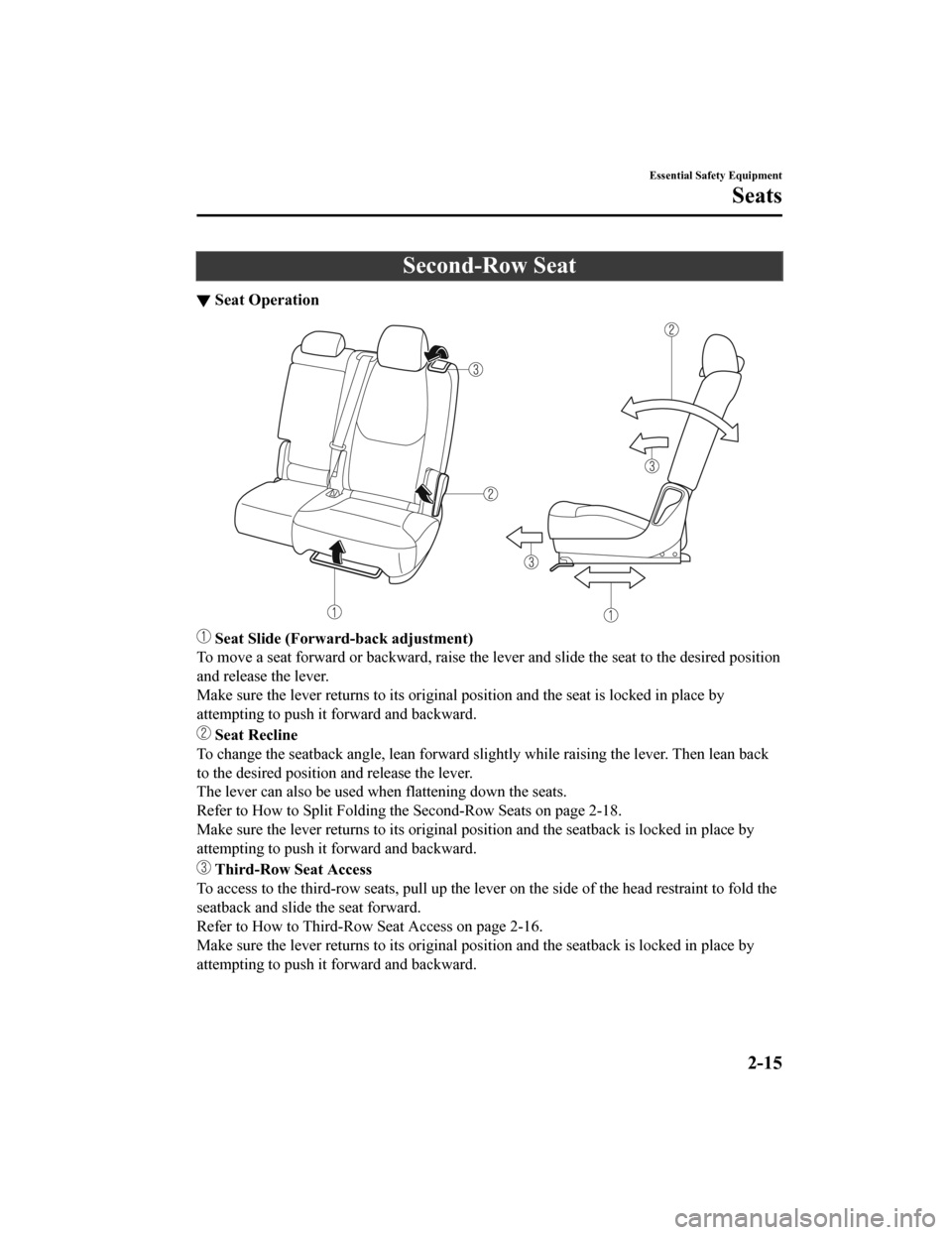
Second-Row Seat
Ō¢╝Seat Operation
Seat Slide (Forward-back adjustment)
To move a seat forward or backward, raise the lever and slide t he seat to the desired position
and release the lever.
Make sure the lever returns to i ts original position and the seat is locked in place by
attempting to push it forward and backward.
Seat Recline
To change the seatback angle, lean forward slightly while raisi ng the lever. Then lean back
to the desired position and release the lever.
The lever can also be used when flattening down the seats.
Refer to How to Split Folding the Second-Row Seats on page 2-18 .
Make sure the lever returns to i ts original position and the seatback is locked in place by
attempting to push it forward and backward.
Third-Row Seat Access
To access to the third-row seats , pull up the lever on the side of the head restraint to fold the
seatback and slide the seat forward.
Refer to How to Third-Row Seat Access on page 2-16.
Make sure the lever returns to i ts original position and the seatback is locked in place by
attempting to push it forward and backward.
Essential Safety Equipment
Seats
2-15
CX-9_8HB2-EA-18G_Edition1 2018-5-11 13:09:27
Page 29 of 692
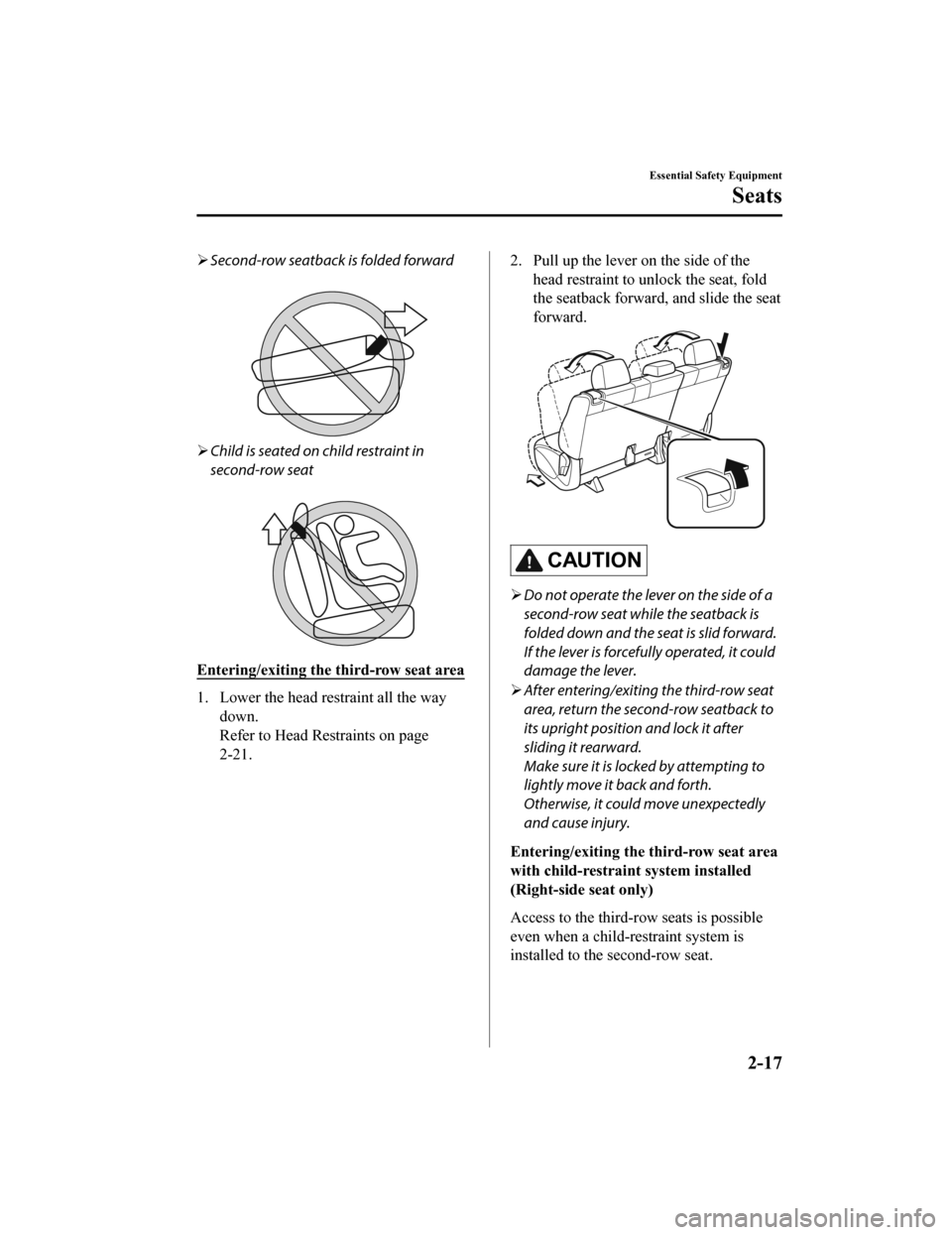
’āśSecond-row seatback is folded forward
’āśChild is seated on child restraint in
second-row seat
Entering/exiting the third-row seat area
1. Lower the head restraint all the way
down.
Refer to Head Restraints on page
2-21.
2. Pull up the lever on the side of the
head restraint to unl ock the seat, fold
the seatback forward, and slide the seat
forward.
CAUTION
’āś Do not operate the lever on the side of a
second-row seat while the seatback is
folded down and the seat is slid forward.
If the lever is forcefully operated, it could
damage the lever.
’āś After entering/exiting the third-row seat
area, return the second-row seatback to
its upright position and lock it after
sliding it rearward.
Make sure it is locked by attempting to
lightly move it back and forth.
Otherwise, it could move unexpectedly
and cause injury.
Entering/exiting the third-row seat area
with child-restraint system installed
(Right-side seat only)
Access to the third-row seats is possible
even when a child-restraint system is
installed to the second-row seat.
Essential Safety Equipment
Seats
2-17
CX-9_8HB2-EA-18G_Edition1 2018-5-11 13:09:27
Page 30 of 692
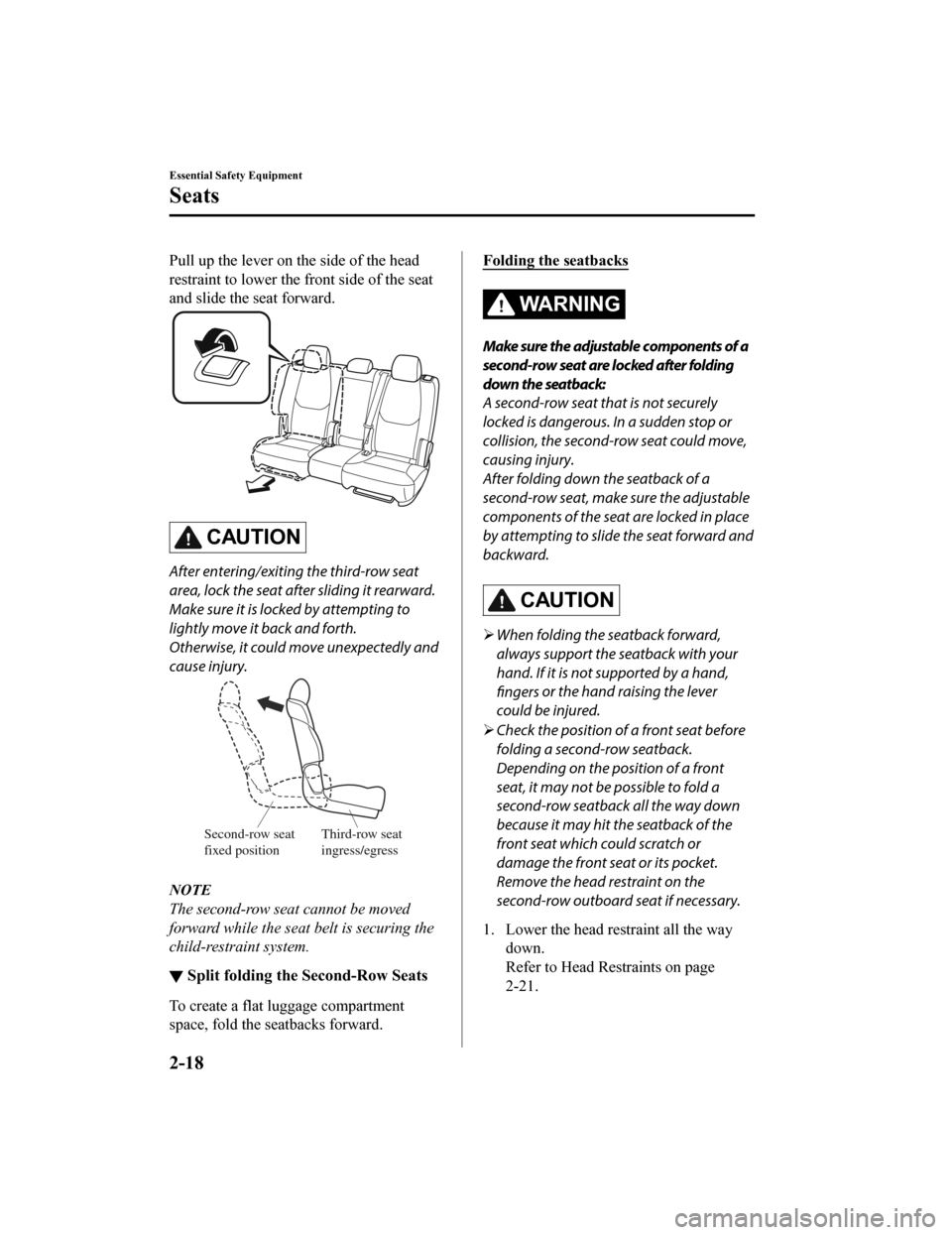
Pull up the lever on the side of the head
restraint to lower the front side of the seat
and slide the seat forward.
CAUTION
After entering/exiting the third-row seat
area, lock the seat after sliding it rearward.
Make sure it is lock ed by attempting to
lightly move it back and forth.
Otherwise, it could move unexpectedly and
cause injury.
Second-row seat
fixed position Third-row seat
in
gress/egress
NOTE
The second-row seat cannot be moved
forward while the seat belt is securing the
child-restraint system.
Ō¢╝
Split folding the Second-Row Seats
To create a flat luggage compartment
space, fold the seatbacks forward.
Folding the seatbacks
WA R N I N G
Make sure the adjustable components of a
second-row seat are locked after folding
down the seatback:
A second-row seat that is not securely
locked is dangerous. In a sudden stop or
collision, the second-row seat could move,
causing injury.
After folding down the seatback of a
second-row seat, make
sure the adjustable
components of the seat are locked in place
by attempting to slide the seat forward and
backward.
CAUTION
’āś When folding the seatback forward,
always support the seatback with your
hand. If it is not supported by a hand,
fingers or the hand raising the lever
could be injured.
’āś Check the position of a front seat before
folding a second-row seatback.
Depending on the position of a front
seat, it may not be possible to fold a
second-row seatback all the way down
because it may hit the seatback of the
front seat which could scratch or
damage the front seat or its pocket.
Remove the head restraint on the
second-row outboard seat if necessary.
1. Lower the head restraint all the way down.
Refer to Head Restraints on page
2-21.
Essential Safety Equipment
Seats
2-18
CX-9_8HB2-EA-18G_Edition1 2018-5-11 13:09:27
Page 31 of 692

2. Raise the lever on the side of thesecond-row seat to fold down the
seatback.
NOTE
To create a flat luggage compartment
space from the rear of the vehicle to the
back of the front seats, fold the second-row
and third-row seats (page 2-20).
To return the seatback to its upright
position:
WA R N I N G
When returning a seatback to its upright
position, make sure the 3-point seat belt is
not caught in the seatback and the 3-point
seat belt is not twisted:
If the seat belt is used while it is twisted and
caught in the seatback, the seat belt
cannot function at its full capacity, which
could cause serious injury or death.
1. Make sure that the seat belt is not stuckin the second-row seat and it is not
twisted, then raise the seatback while
preventing the seat belt from being
caught in the seatback.
2. Press the seatback rearward and lock it in place. After returning the seatback
to its upright posit ion, make sure it is
securely locked.
Essential Safety Equipment
Seats
2-19
CX-9_8HB2-EA-18G_Edition1 2018-5-11 13:09:27
Page 35 of 692
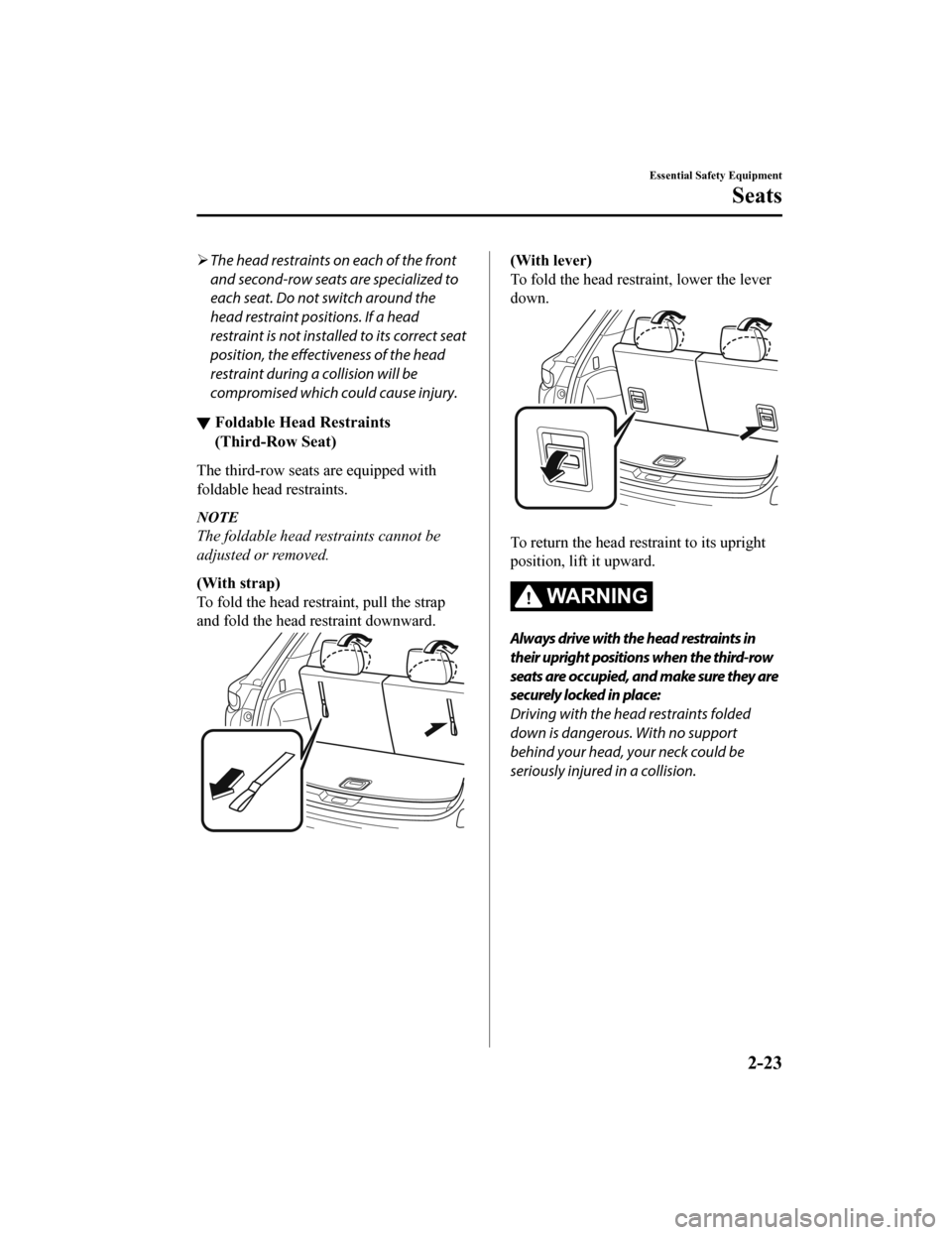
’āśThe head restraints on each of the front
and second-row seats are specialized to
each seat. Do not switch around the
head restraint positions. If a head
restraint is not installed to its correct seat
position, the effectiveness of the head
restraint during a collision will be
compromised which could cause injury.
Ō¢╝ Foldable Head Restraints
(Third-Row Seat)
The third-row seats are equipped with
foldable head
restraints.
NOTE
The foldable head restraints cannot be
adjusted or removed.
(With strap)
To fold the head restraint, pull the strap
and fold the head restraint downward.
(With lever)
To fold the head restraint, lower the lever
down.
To return the head restraint to its upright
position, lift it upward.
WA R N I N G
Always drive with the head restraints in
their upright positions when the third-row
seats are occupied, and make sure they are
securely locked in place:
Driving with the head restraints folded
down is dangerous. With no support
behind your head, your neck could be
seriously injured in a collision.
Essential Safety Equipment
Seats
2-23
CX-9_8HB2-EA-18G_Edition1 2018-5-11 13:09:27
Page 40 of 692
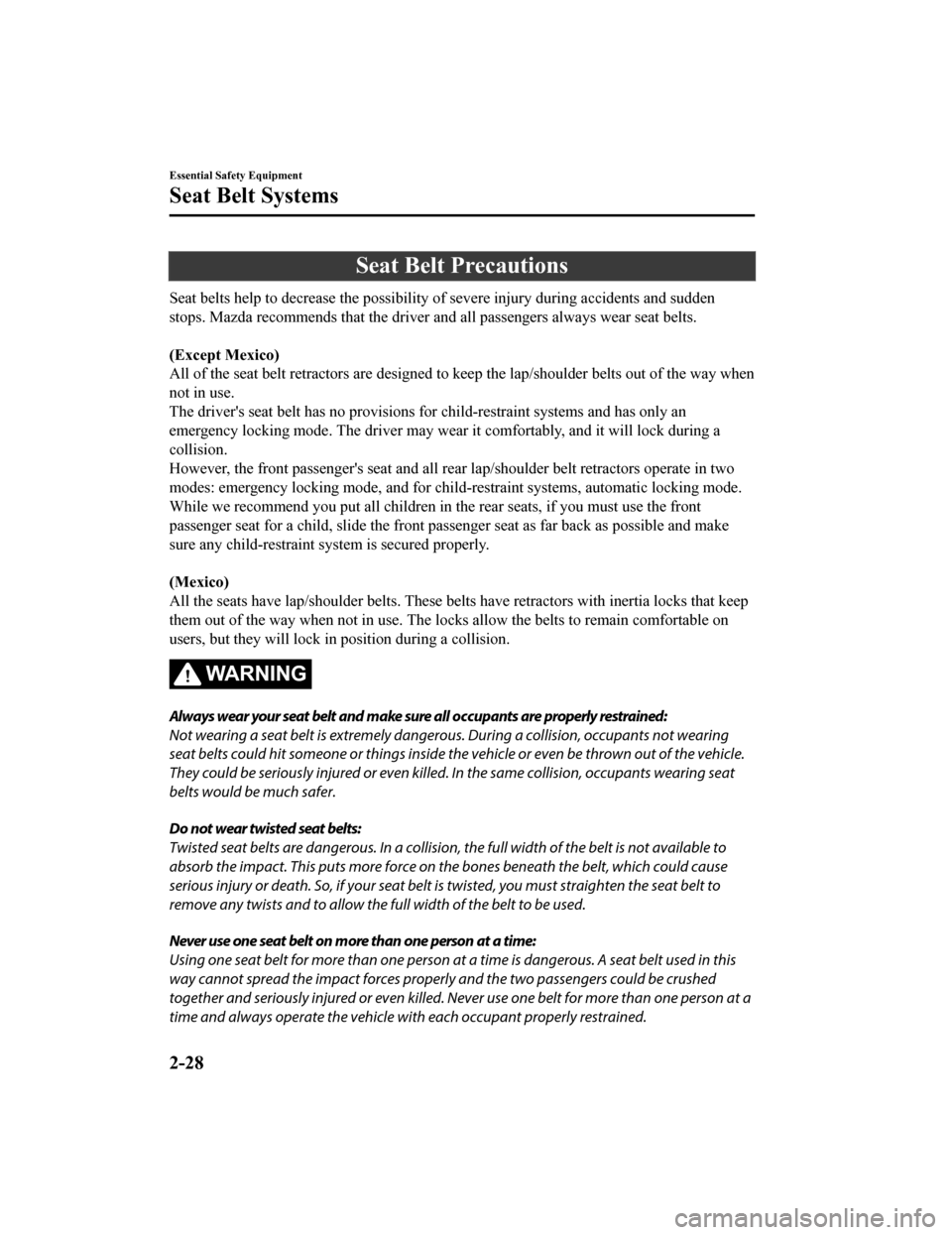
Seat Belt Precautions
Seat belts help to decrease the possibility of severe injury during accidents and sudden
stops. Mazda recommends that the driver and all passengers always wear seat belts.
(Except Mexico)
All of the seat belt retractors are designed to keep the lap/sh oulder belts out of the way when
not in use.
The driver's seat belt has no provisions for child-restraint sy stems and has only an
emergency locking mode. The driver may wear it comfortably, and it will lock during a
collision.
However, the front passenger's seat and all rear lap/shoulder b elt retractors operate in two
modes: emergency locking mode, and for child-restraint systems, automatic locking mode.
While we recommend you put all chi ldren in the rear seats, if you must use the front
passenger seat for a child, slide the front passenger seat as f ar back as possible and make
sure any child-restraint sy stem is secured properly.
(Mexico)
All the seats have lap/shoulder belts. These belts have retract ors with inertia locks that keep
them out of the way when not in use. The locks allow the belts to remain comfortable on
users, but they will lock in position during a collision.
WA R N I N G
Always wear your seat belt and make sure all occupants are properly restrained:
Not wearing a seat belt is extremely dangerous . During a collision, occupants not wearing
seat belts could hit someone or things inside th e vehicle or even be thrown out of the vehicle.
They could be seriously injured or even killed. In the same collision, occupants wearing seat
belts would be much safer.
Do not wear twisted seat belts:
Twisted seat belts are dangerous. In a collision, the full width of the belt is not available to
absorb the impact. This puts more force on the bones beneath the belt, which could cause
serious injury or death. So, if your seat belt is twisted, you must straighten the seat belt to
remove any twists and to allow the full width of the belt to be used.
Never use one seat belt on more than one person at a time:
Using one seat belt for more than one person at a time is dangerous. A seat belt used in this
way cannot spread the impact forces properly and the two passengers could be crushed
together and seriously injured or even killed. Never use one belt for more than one person at a
time and always operate the vehicle with each occupant properly restrained.
Essential Safety Equipment
Seat Belt Systems
2-28
CX-9_8HB2-EA-18G_Edition1 2018-5-11 13:09:27
Page 42 of 692
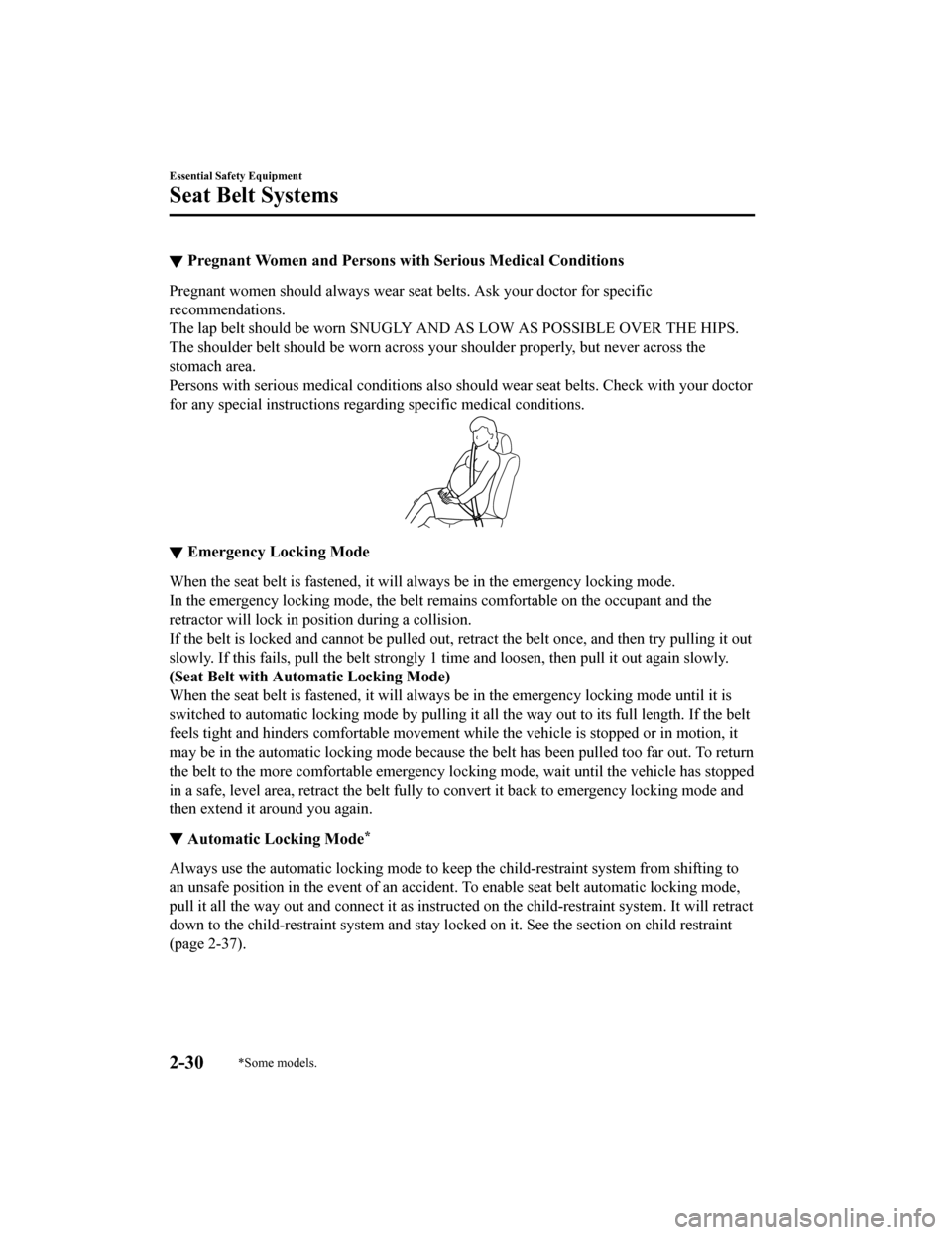
Ō¢╝Pregnant Women and Persons with Serious Medical Conditions
Pregnant women should always wea
r seat belts. Ask your doctor for specific
recommendations.
The lap belt should be worn SNUGLY AND AS LOW AS POSSIBLE OVER THE HIPS.
The shoulder belt should be worn across your shoulder properly, but never across the
stomach area.
Persons with serious medical conditions also should wear seat b elts. Check with your doctor
for any special instructions regarding specific medical conditi ons.
Ō¢╝Emergency Locking Mode
When the seat belt is fastened, it will always be in the emergency locking mode.
In the emergency locking mode, the belt remains comfortable on
the occupant and the
retractor will lock in pos ition during a collision.
If the belt is locked and cannot be pulled out, retract the bel t once, and then try pulling it out
slowly. If this fails, pull the belt strongly 1 time and loosen , then pull it out again slowly.
(Seat Belt with Autom atic Locking Mode)
When the seat belt is fastened, it will always be in the emergency locking mode until it is
switched to automatic locking mode by pulling it all the way ou t to its full length. If the belt
feels tight and hinders comforta ble movement while the vehicle is stopped or in motion, it
may be in the automatic locking mode because the belt has been pulled too far out. To return
the belt to the more comfortable emergency locking mode, wait u ntil the vehicle has stopped
in a safe, level area, retract t he belt fully to convert it back to emergency locking mode and
then extend it around you again.
Ō¢╝ Automatic Locking Mode*
Always use the automatic locking mode to keep the child-restrai
nt system from shifting to
an unsafe position in the event of an accident. To enable seat belt automatic locking mode,
pull it all the way out and connect it as instructed on the chi ld-restraint system. It will retract
down to the child-restraint system and stay locked on it. See t he section on child restraint
(page 2-37).
Essential Safety Equipment
Seat Belt Systems
2-30*Some models.
CX-9_8HB2-EA-18G_Edition1 2018-5-11 13:09:27
Page 44 of 692
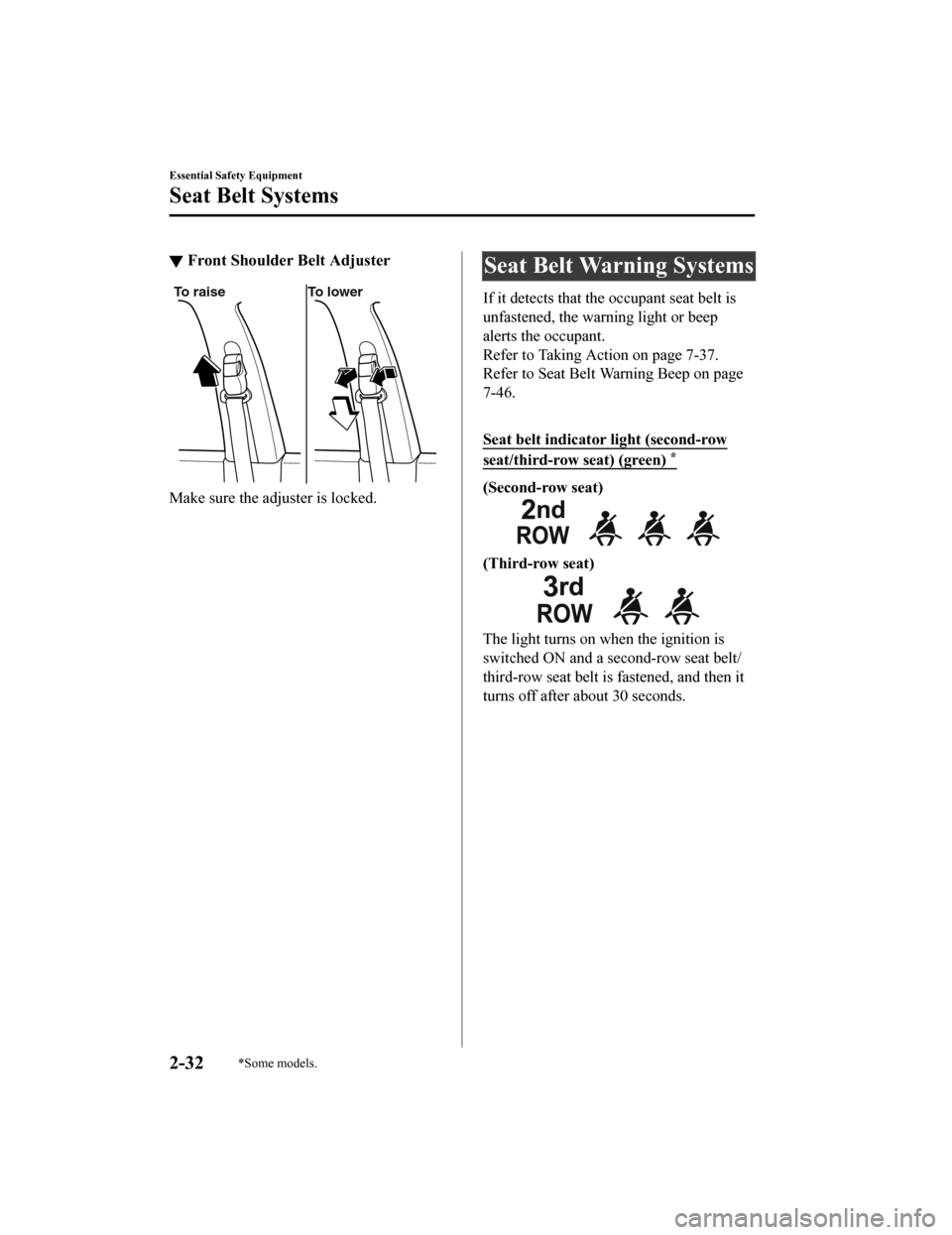
Ō¢╝Front Shoulder Belt Adjuster
To raise
To lower
Make sure the adjuster is locked.
Seat Belt Warning Systems
If it detects that the occupant seat belt is
unfastened, the warning light or beep
alerts the occupant.
Refer to Taking Action on page 7-37.
Refer to Seat Belt Warning Beep on page
7-46.
Seat belt indicator light (second-row
seat/third-row seat) (green) *
(Second-row seat)
(Third-row seat)
The light turns on when the ignition is
switched ON and a second-row seat belt/
third-row seat belt is fastened, and then it
turns off after about 30 seconds.
Essential Safety Equipment
Seat Belt Systems
2-32*Some models.
CX-9_8HB2-EA-18G_Edition1 2018-5-11 13:09:27
Page 52 of 692

Seating a child in a child-restraint system on the front passenger seat is dangerous under
certain conditions (With Front Passenger Occupant Classification System):
Your vehicle is equipped with front passenger occupant classification sensor. Even with the
front passenger occupant classification sensor, if you must use the front passenger seat to
seat a child, using a child-restraint system on the front passenger seat under the following
conditions increases the danger of the front passenger air bag deploying and could result in
serious injury or death to the child.
’āś The front passenger air bag deactivation indica tor light does not illuminate when seating a
child in the child-restraint system.
’āś Luggage or other items are placed on the seat with the child in the child-restraint system.
’āś A rear passenger or luggage pushing or pulling down on the front passenger seatback.
’āś Luggage or other items are placed on the seatback or hung on the head restraint.
’āś The seat is washed.
’āś Liquids are spilled on the seat.
’āś The front passenger seat is moved backward, pushing into luggage or other items placed
behind it.
’āś The front passenger seatback contacts the rear seat.
’āś Luggage or other items are placed between the front passenger seat and driver seat.
’āś An electric device is put on the front passenger's seat.
’āś An additional electrical device, such as a seat warmer is installed to the surface of the front
passenger seat.
The designated positions with seat belts on the rear seats are the safest places for children.
Always use seat belts and child restraints.
Do not allow a child or anyone to lean over or against the side window of a vehicle with side
and curtain air bags:
It is dangerous to allow anyone to lean over or against the side window, the area of the front
passenger seat, the front and rear window pilla rs and the roof edge along both sides from
which the side and curtain air bags deploy, even if a child-restraint system is used. The impact
of inflation from a side or curtain air bag could ca
use serious injury or death to an out of
position child. Furthermore, leaning over or against the front door could block the side and
curtain air bags and eliminate the advantages of supplemental protecti on. With the front air
bag and the additional side air bag that comes out of the front seat, the rear seat is always a
better location for children. Take special care no t to allow a child to lean over or against the
side window, even if the child is seated in a child-restraint system.
Essential Safety Equipment
Child Restraint
2-40
CX-9_8HB2-EA-18G_Edition1 2018-5-11 13:09:27
Page 62 of 692

Only use a tether anchor designed for the
second-row seats:
Using a third-row seat tether anchor on the
second-row seat is dangerous. The
child-restraint system cannot be installed
correctly which may result in death or
injury to the child in a collision.
Tether strap
Third-row seatSecond-row
outboard/center
Always route the tether straps to the sides
of the head restraint (Third-row seat):
Routing the tether straps on top of the
head restraint is dangerous. In a collision
the tether straps could slide
off the head
restraint and loosen the child-restraint
system. The child-restraint system could
move which may result in death or injury to
the child.
Tether strap
ForwardThird-row seat
Ō¢╝Using Automatic Locking Mode
(Except Mexico)
Follow these instructions when using a
child-restraint system, unless you are
attaching a LATCH-equipped
child-restraint syst
em to the rear LATCH
lower anchors. Refer to ŌĆ£Using LATCH
Lower AnchorŌĆØ (page 2-57).
NOTE
Follow the child- restraint system
manufacturer's instructions carefully. If
you are not sure whether you have a
LATCH system or tether, check in the
child-restraint system manufacturer's
instructions and follow them accordingly.
Depending on the type of child-restraint
system, it may use LATCH system instead
of seat belts or if the belt goes across the
child's chest, may recommend against
using automatic locking mode.
1. (Second-row seat)
Adjust the second-row seat position
using the following procedure.
Fold the second-row seatback
forward.
Raise the second-row seatback until
a click sound is heard and it is locked
in place.
2. If the second-row seat is reclined, return it to the upright position.
Essential Safety Equipment
Child Restraint
2-50
CX-9_8HB2-EA-18G_Edition1 2018-5-11 13:09:27